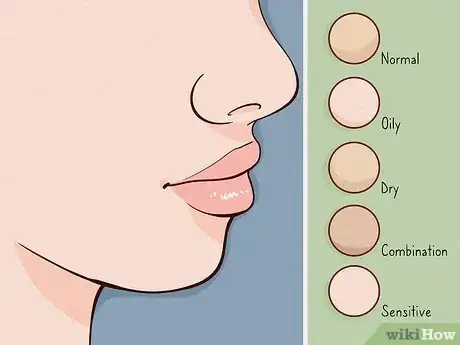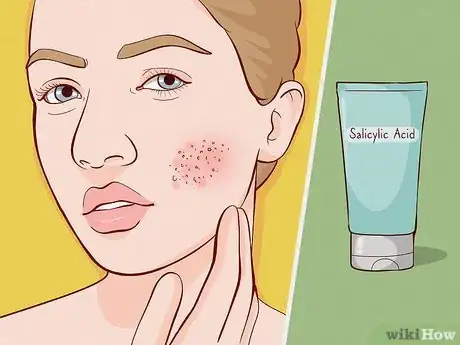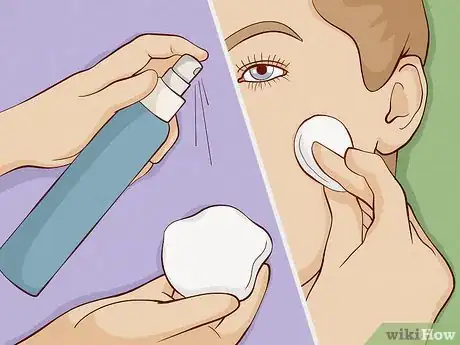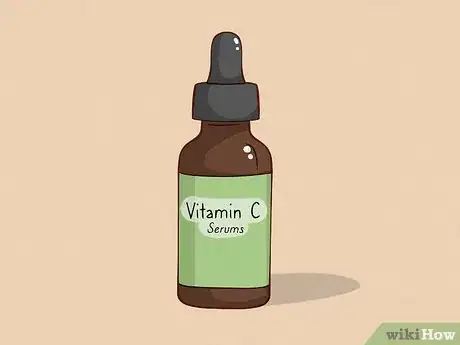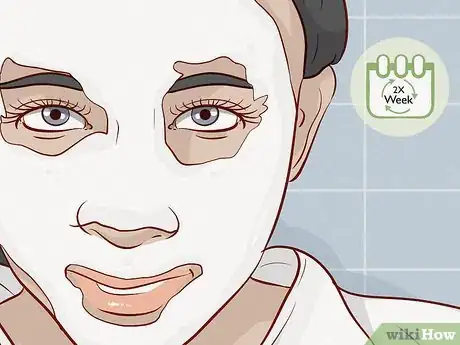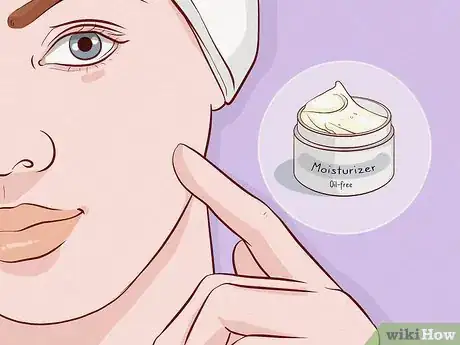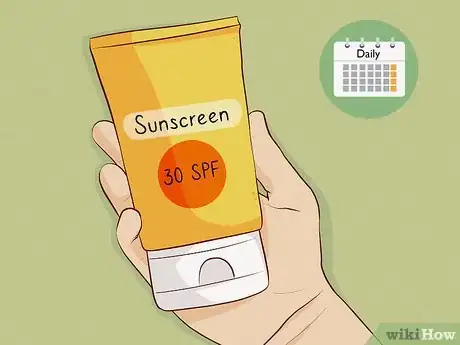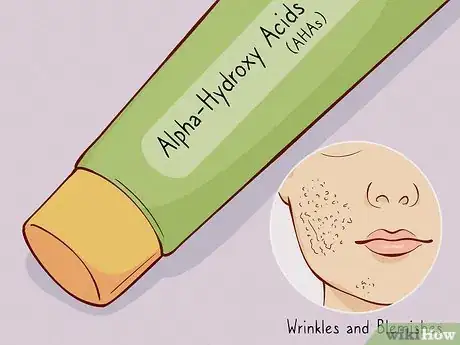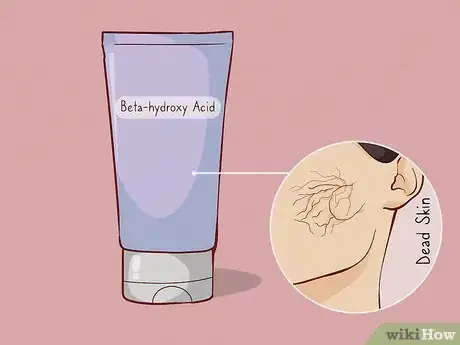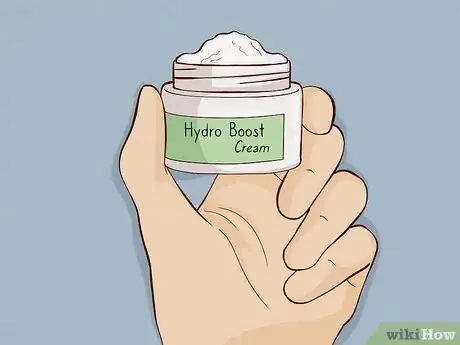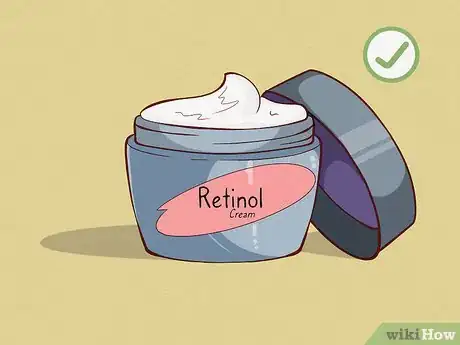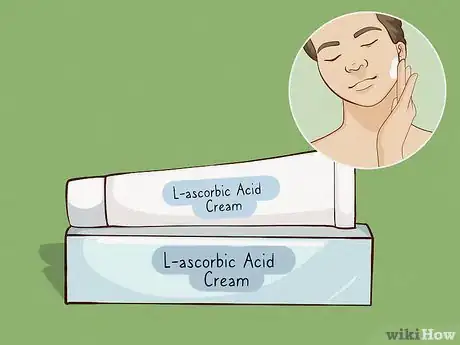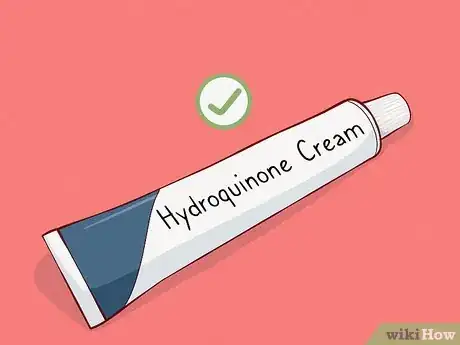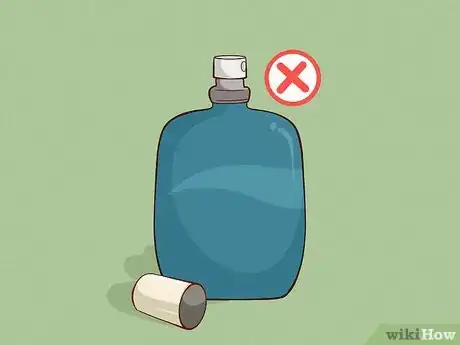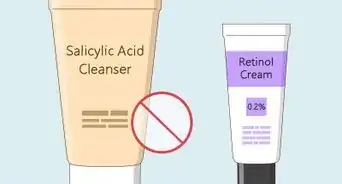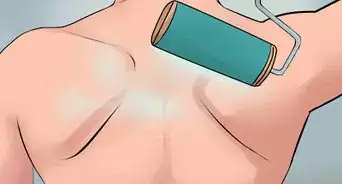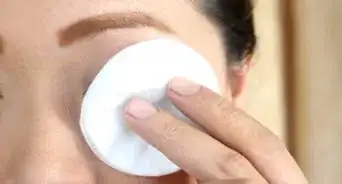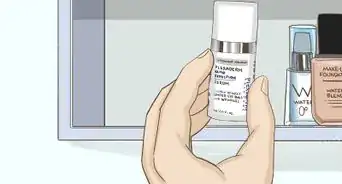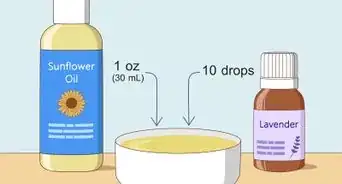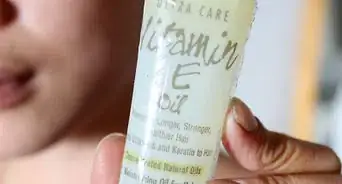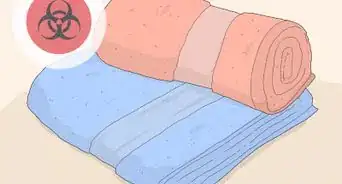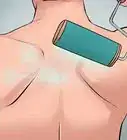This article was co-authored by Paul Friedman, MD and by wikiHow staff writer, Janice Tieperman. Paul Friedman, MD, is a Board-Certified Dermatologist, and the Director and Founder of the Dermatology & Laser Surgery Center in Houston, Texas. He has over 25 years of experience and specializes in Mohs micrographic surgery, dermatologic laser surgery, and cosmetic dermatology. Dr. Friedman is the current President of the American Society for Laser Medicine & Surgery and was named by Newsweek Magazine as one of the Best Dermatologists in America for Laser Treatments. His awards include the Husk Prize for his research in dermatologic surgery and the Young Investigator's Writing Competition Award of the American Society for Dermatologic Surgery. Dr. Friedman completed his dermatology residency at the New York University School of Medicine and received his medical degree with the highest honors from the University of Tennessee Health Science Center, College of Medicine.
There are 20 references cited in this article, which can be found at the bottom of the page.
wikiHow marks an article as reader-approved once it receives enough positive feedback. In this case, 91% of readers who voted found the article helpful, earning it our reader-approved status.
This article has been viewed 74,503 times.
It’s true: good skin care products and a healthy skincare routine are essential to having happy, healthy skin. But with all the products on the shelves, how are you supposed to know which ones are best for you and your skin care needs? No worries—you’re not in this alone. We’re here to help you find the best skin care ingredients and products for your skin type and complexion.
Steps
Getting to Know Your Skin's Needs
-
1What is your skin type? Your skin type is the default condition of your skin on any given day. Many skin care products cater to specific skin types, so it helps to know which one you have before you start shopping around.[1] Here are the different categories:
- Normal: Skin that’s not especially dry, oily, or sensitive
- Oily: Skin with a shiny, greasy sheen
- Dry: Skin that itches, flakes, or feels rough to the touch
- Combination: A mixture of dry and oily skin
- Sensitive: Skin that tends to react to skincare products[2]
-
2Do you want to target any skin concerns or issues in your skincare routine? Maybe you’re battling a pesky round of acne, dealing with wrinkles, or coping with a rosacea flare-up. Whatever the case, look for skincare products that address these specific issues and concerns.[3] You might:Advertisement
-
3Do you have any habits that directly affect your skin? Many different factors affect the way your skin looks and feels. This, in turn, affects the skincare products you’ll need to use. For instance, smoking or spending a lot of time in the sun means you'll want products that target collagen production and sun damage.[6]
Building a Healthy Skin Care Routine
-
1Wash your face with a gentle cleanser twice per day. Cleansers help clear away any oil, grime, and anything else that’s collected on your face.[7] Dermatologists suggest squeezing a tiny bit of cleanser onto your fingertips and lightly massaging it into your skin. Then, rinse off any leftover suds with slightly warm water, and blot your skin with a gentle cloth until it’s completely dry.[8] Here are some skin-specific suggestions:
- Oily Skin: Gel cleanser with glycolic and salicylic acid
- Dry Skin: Cream cleanser with glycerin and petrolatum, lanolin, or ceramides
- Combination Skin: Gentle, balanced cleanser
- Sensitive Skin: Mild cleanser without dye, soap, or fragrance[9]
-
2Nourish your freshly-cleaned skin with toner up to twice a day. Toner helps nourish, lower redness, and eliminate dry sections on your skin.[10] All you have to do is squeeze a few drops of product onto a cotton ball and dab all over your damp skin after you’ve cleansed. Here are some skin type-specific suggestions:[11]
- Dry and Normal Skin: Toner with hyaluronic acid
- Oily Skin: Toner with alpha and beta hydroxy acids
- Sensitive Skin: Toner with hyaluronic acid that’s fragrance-free
- All Skin Types: Any toner that’s alcohol-free with antioxidants
-
3Target specific skin issues with serums. Are you noticing some fine lines starting to form, or does your skin just always seem to be inflamed? Whatever the case, serums are a great way to tackle specific issues.[12]
- Vitamin C serums are a really popular option that can help your skin look brighter and less red. They can even help boost collagen production, which helps your skin look a bit more youthful.[13] This could be helpful if you just quit smoking, since cigarettes hurt your skin’s collagen.[14]
- Although serums are an optional part of most skincare routines, some people find them helpful.[15]
-
4Exfoliate your face up to 2 times each week.[16] Exfoliating products help clear away dead skin cells, but they shouldn’t be used every day.[17] Instead, experts advise using an exfoliator up to twice a week, between your cleanser and moisturizer.[18] Here are some skin type-specific suggestions:
- Oily Skin: Use a mechanical exfoliator or strong chemical exfoliator
- Dry Skin: Use a gentle chemical exfoliator
- Sensitive Skin: Use a gentle chemical exfoliator
- Mechanical exfoliators require physical motion to exfoliate your skin, like using a bristled brush or exfoliating scrub. Chemical exfoliators are products made with exfoliating ingredients and aren’t as rough on your skin.[19]
-
5Hydrate your skin every day with lotion or moisturizer while it’s damp. Moisturizers help lock moisture into your face, creating a vibrant glow.[20] Dermatologists suggest applying this product throughout the year, so your skin can always stay hydrated.[21] Here are some specific product suggestions, depending on your skin type:
- Oily Skin: Water-based, oil-free moisturizer
- Dry Skin: Oil-based moisturizer
- Combination Skin: Medium-weight lotion
- Sensitive Skin: Hypoallergenic and fragrance-free moisturizer[22]
-
6Apply 30 SPF sunscreen every day to protect your skin. Daily sun exposure can damage your skin over time, so it’s important to stay protected.[23] Rub sunscreen on any exposed parts of your skin about 15 minutes before you plan on heading out the door—this way, the product has enough time to soak into your skin.[24]
- A cherry tomato-sized squirt of sunscreen should be enough to protect your face.[25]
- Try to apply a new layer of sunscreen every 2 hours if you spend a lot of time out in the sun.[26]
- Remember: you should always wear sunscreen when you head outside, even if you have a tan complexion or darker skin tone.[27]
Choosing the Right Ingredients for Your Skin
-
1Treat wrinkles and blemishes with alpha-hydroxy acids (AHAs). Also known as tartaric, glycolic, lactic, and citric acids, AHAs help reduce age spots, wrinkles, fine lines, and pigmentation issues. You can find them in a variety of over-the-counter creams and lotions.[28]
- Skincare experts suggest picking out products with a low AHA concentration so you don’t bother your skin. Anywhere between 10 and 15% should be good!
-
2Clear away dead skin with beta-hydroxy acids. Also known as salicylic acid, this ingredient helps boost the tone and texture of skin damaged by the sun. It’s also a common ingredient in acne treatments. You can find it in plenty of over-the-counter skincare productions, as well as in prescription treatments.[29]
- Products with beta-hydroxy acids may be a little easier on your skin than products with AHAs.
-
3Hydrate and firm your skin with hyaluronic acid. Hyaluronic acid is found naturally in your joints and skin, but your body’s levels of it decrease when you get older. Thankfully, there’s plenty of hyaluronic acid in topical, over-the-counter products, which hydrate your skin and tackle your wrinkles head-on.[30]
-
4Improve your skin’s appearance with retinol. This ingredient reduces fine lines, decreases wrinkles, and gives your skin texture a boost. You can find it in a variety of creams and serums at your local drugstore.[31]
-
5Get younger-looking skin with L-ascorbic acid. Also known as vitamin C, L-ascorbic acid helps boost your skin’s collagen production, which helps reduce wrinkles, lines, and other blemishes. Skincare products with L-ascorbic acid may irritate your skin at first, but your skin should adjust over time.[32]
- You can find L-ascorbic acid in plenty of over-the-counter skincare products.
-
6Lighten your skin with hydroquinone. This ingredient directly impacts your melanin production and can treat different types of hyperpigmentation, like freckles, acne scars, and age spots. [33] You can easily find hydroquinone creams at your local pharmacy, but you’ll need a prescription to get a more potent formula.[34]
- Keep in mind that the medical community has a divided opinion about hydroquinone, and some health professionals link it with serious health issues.[35]
-
7Blacklist products that are made with potentially dangerous ingredients. Unfortunately, not all skincare products and ingredients are created equally. Some skincare ingredients are actually harmful to your body, and can potentially lead to serious side effects. Here are a few ingredients to watch out for:[36]
- Fragrance
- Homosalate
- Nanomaterials
- Octinoxate
- Parabens
- For a full list of concerning ingredients, check out this list: https://www.safecosmetics.org/get-the-facts/chem-of-concern/
Expert Q&A
-
QuestionHow do I know what skincare works for me?
 Paul Friedman, MDPaul Friedman, MD, is a Board-Certified Dermatologist, and the Director and Founder of the Dermatology & Laser Surgery Center in Houston, Texas. He has over 25 years of experience and specializes in Mohs micrographic surgery, dermatologic laser surgery, and cosmetic dermatology. Dr. Friedman is the current President of the American Society for Laser Medicine & Surgery and was named by Newsweek Magazine as one of the Best Dermatologists in America for Laser Treatments. His awards include the Husk Prize for his research in dermatologic surgery and the Young Investigator's Writing Competition Award of the American Society for Dermatologic Surgery. Dr. Friedman completed his dermatology residency at the New York University School of Medicine and received his medical degree with the highest honors from the University of Tennessee Health Science Center, College of Medicine.
Paul Friedman, MDPaul Friedman, MD, is a Board-Certified Dermatologist, and the Director and Founder of the Dermatology & Laser Surgery Center in Houston, Texas. He has over 25 years of experience and specializes in Mohs micrographic surgery, dermatologic laser surgery, and cosmetic dermatology. Dr. Friedman is the current President of the American Society for Laser Medicine & Surgery and was named by Newsweek Magazine as one of the Best Dermatologists in America for Laser Treatments. His awards include the Husk Prize for his research in dermatologic surgery and the Young Investigator's Writing Competition Award of the American Society for Dermatologic Surgery. Dr. Friedman completed his dermatology residency at the New York University School of Medicine and received his medical degree with the highest honors from the University of Tennessee Health Science Center, College of Medicine.
Board Certified Dermatologist, American Board of Dermatology Keep in mind what type of skin you have and choose products that are made specifically for it.
Keep in mind what type of skin you have and choose products that are made specifically for it. -
QuestionShall I use face scrub for removing black dots on my face?
 Community AnswerThose black dots are blackheads. Try getting pore strips, which pull out the blackheads, leaving your skin clear. Get them at your local supermarket or drugstore.
Community AnswerThose black dots are blackheads. Try getting pore strips, which pull out the blackheads, leaving your skin clear. Get them at your local supermarket or drugstore.
References
- ↑ Paul Friedman, MD. Board Certified Dermatologist, American Board of Dermatology. Expert Interview. 8 April 2020.
- ↑ https://www.aad.org/public/everyday-care/skin-care-basics/care/skin-care-budget
- ↑ https://my.clevelandclinic.org/health/drugs/10981-know-your-skin-type-before-choosing-skin-care-products
- ↑ https://my.clevelandclinic.org/health/articles/10980-understanding-the-ingredients-in-skin-care-products
- ↑ https://www.aad.org/public/diseases/rosacea/triggers/tips
- ↑ https://my.clevelandclinic.org/health/drugs/10981-know-your-skin-type-before-choosing-skin-care-products
- ↑ https://www.aad.org/public/everyday-care/skin-care-basics/care/skin-care-budget
- ↑ https://www.youtube.com/watch?v=AeXsfB2ud-o&t=17s
- ↑ https://dermcollective.com/face-cleanser/
- ↑ https://www.nm.org/healthbeat/healthy-tips/do-you-really-need-a-skin-care-routine
- ↑ https://www.forbes.com/sites/nomanazish/2021/03/31/do-you-really-need-a-face-toner-heres-what-the-derms-say/?sh=42810244446f
- ↑ https://www.nm.org/healthbeat/healthy-tips/do-you-really-need-a-skin-care-routine
- ↑ https://www.ucihealth.org/blog/2020/01/skincare
- ↑ https://www.mayoclinic.org/healthy-lifestyle/adult-health/in-depth/skin-care/art-20048237
- ↑ https://www.nm.org/healthbeat/healthy-tips/do-you-really-need-a-skin-care-routine
- ↑ https://www.nm.org/healthbeat/healthy-tips/do-you-really-need-a-skin-care-routine
- ↑ https://www.aad.org/public/everyday-care/skin-care-secrets/routine/safely-exfoliate-at-home
- ↑ https://www.nm.org/healthbeat/healthy-tips/do-you-really-need-a-skin-care-routine
- ↑ https://www.aad.org/public/everyday-care/skin-care-secrets/routine/safely-exfoliate-at-home
- ↑ https://www.aad.org/public/everyday-care/skin-care-basics/care/skin-care-budget
- ↑ https://www.utmedicalcenter.org/the-importance-of-moisturizing/
- ↑ https://www.mayoclinic.org/diseases-conditions/dry-skin/in-depth/moisturizers/art-20044232
- ↑ https://www.aad.org/public/everyday-care/skin-care-basics/care/skin-care-budget
- ↑ https://www.aad.org/public/diseases/skin-cancer/prevent/sunscreen-apply
- ↑ https://www.nytimes.com/guides/tmagazine/skincare-routine
- ↑ https://www.aad.org/public/everyday-care/skin-care-basics/care/skin-care-budget
- ↑ https://my.clevelandclinic.org/health/drugs/10981-know-your-skin-type-before-choosing-skin-care-products
- ↑ https://my.clevelandclinic.org/health/articles/10980-understanding-the-ingredients-in-skin-care-products
- ↑ https://my.clevelandclinic.org/health/articles/10980-understanding-the-ingredients-in-skin-care-products
- ↑ https://my.clevelandclinic.org/health/articles/10980-understanding-the-ingredients-in-skin-care-products
- ↑ https://my.clevelandclinic.org/health/articles/10980-understanding-the-ingredients-in-skin-care-products
- ↑ https://my.clevelandclinic.org/health/articles/10980-understanding-the-ingredients-in-skin-care-products
- ↑ https://www.aocd.org/page/Hydroquinone
- ↑ https://my.clevelandclinic.org/health/articles/10980-understanding-the-ingredients-in-skin-care-products
- ↑ https://www.safecosmetics.org/get-the-facts/chemicals-of-concern/hydroquinone/
- ↑ https://www.safecosmetics.org/get-the-facts/chem-of-concern/
- ↑ https://www.aad.org/public/diseases/acne/skin-care/habits-stop
- ↑ https://www.aad.org/public/everyday-care/skin-care-basics/care/skin-care-budget
